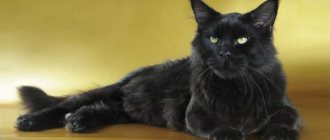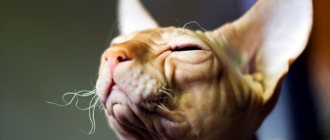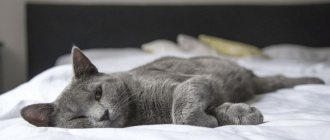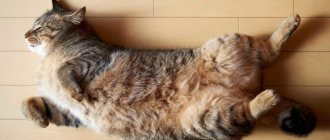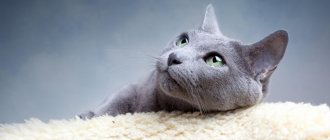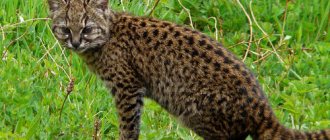Twenty-seven questions about cats
- Why does a cat crouch when it sees a bird?
When a cat catches its prey, it crouches several times. These movements indicate that the animal intends to attack. This is one guess. The second says that such squats are a gesture of discontent. When a cat hunts in natural conditions, it is inconspicuous and almost silent. Therefore, if the prey turns out to be unattainable, it will not scream with discontent, but will make such a silent and unnoticeable gesture.
At birth, kittens cannot see or hear.
2. Why does a cat drag food onto the floor instead of eating directly in the bowl?
The majority of cats do not like close contact of food with dishes. This is aggravated by the fact that if the container is not wide enough, then some of the food may be inaccessible to the tongue. For this reason, cats prefer low and wide containers, and their favorite utensil is the floor.
Cats' whiskers are one of their sense organs.
3. Why might a cat that is petted for a long time bite or scratch?
As a rule, the reason for this behavior in cats is excessive attention to those parts of the cat’s body that are particularly sensitive - the tail, nose, ears, belly and others. If the cat is unhappy, he may first warn his owner with a sound to leave these areas alone, but if he ignores his request, the animal may move on to more active methods of conveying information to the person, such as scratching or biting. In such a situation, this only indicates that the animal is tired of affection or that they have become too inept.
Kittens are born blue-eyed, but by 2-3 months the eye color may change.
4. Why do cats scratch wallpaper and furniture?
It is traditionally believed that cats sharpen their claws in this way. However, in some cases this is not the case, and even if a cat has several scratching posts, she may still periodically sharpen her claws on a sofa or corner of a wall. The reason for such attachment to the above-mentioned objects is that between the toes of a cat's paws there are special glands that secrete a secretion with which the animal marks its territory.
People with heart disease have a chance to live longer if they have a cat.
5. Why do cats sometimes interfere with telephone conversations?
The fact is that if a cat sees its owner talking, but at the same time sees that there is no one in the house except her and the owner, she comes to the conclusion that the owner is talking to her and therefore begins to answer. And the fact that a person holds some kind of thing next to his ear does not mean much to a cat.
Most cats, when sick, hide in a secluded place in the apartment.
6. Why do cats spend so much time licking their fur?
The reason is that, in addition to the fact that licking performs purely hygienic tasks, it is also a means by which the animal restores its mental balance. You can verify this by looking at a cat that has fallen from a chair. After landing, the first thing he will do is not begin to inspect himself for damage, but to lick himself. It may not be a full-fledged wash, but he will definitely lick himself a couple of times. This is similar to what those with a beard do, who like to stroke it with their hand during hours of thought.
The cat can move at a maximum speed of about 50 km/h.
7. Why when a cat is sick does it hide from its owners?
This is the result of an instinctive desire to hide from a stronger predator, which the cat is not able to resist during the period of illness. That is, it is a defensive reaction.
A cat can jump up to 5 times its own height.
8. Why do cats like to drink water that comes out of a tap?
Like many other animals, cats prefer fresh water and food. And in their understanding, flowing water looks fresher, so the water flowing from the tap seems more attractive to them than the one in the bowl. And for this same reason, cats prefer to drink from large containers.
Cats do not like sweets because they do not have such a taste bud.
9. Why don't cats like bathing?
In fact, the majority of these animals treat water quite calmly. If they have the opportunity, they can even fish in it. But this is an independent entry into the water. And it’s a completely different matter when someone grabs a cat tightly, puts it in a container of water, and even dips it. In a cat's understanding, this has little to do with voluntary fishing. Naturally, this does not cause them any pleasure.
Good hearing allows a cat to hear its owner's steps from afar.
10. Why do cats like to scratch window frames?
They do this to check for the presence of a barrier in the form of glass.
11. Why do cats frown when they smell something?
If, while sniffing something, a cat raises its upper lip and wrinkles its nose, this indicates that it is trying to inhale the smell that interests it more deeply so that it reaches the Jacobson's organ located in the cat's mouth.
The number of sounds cats make when communicating reaches several hundred.
12. Why do cats lick plastic bags and photographs?
Thus, they taste the smell, which is indistinguishable to humans.
13. Why do cats sometimes lightly bite a person's skin and hold it for a few seconds?
This is a kind of cat kiss that a cat can give in a particularly complacent state.
Cats make purring sounds from excess emotions.
14. Why do cats sometimes hide their toys in a bowl of water or food?
The territory in which the cat feeds is perceived by it as its property. Therefore, if something happens, she may want to hide her toys in this, the safest place in her opinion. Sometimes a bowl becomes such a place.
15. Why does a cat bring dead mice to its owner?
There is no clear answer to this question yet, but there are four theories:
- the cat wants to save the owner from hunger;
- the cat takes its prey to a safe place where it can eat it when it gets hungry;
- the cat thinks that you are a mediocre hunter and wants to teach you this;
- the cat shows sympathy towards you and gives part of its prey as a sign of friendship.
Over time, cats begin to enter into dialogue with their owner.
16. Why, if you don’t pay attention to a cat for a long time, does it turn its back?
Just like many other animals, cats are good at recognizing visual cues such as gestures or postures. And if a person does not show signs of aggression and simply leaves the cat’s field of vision, the cat also loses interest in the person and turns away.
A cat's tail is a part of the body by which one can recognize the animal's mood and thoughts.
17. Why are some people allergic to cat hair?
In general, allergies are caused not by the cat’s fur itself, but by the protein FEL D1 contained in the cat’s saliva. It gets on the cat's fur when the cat licks or washes itself. Then this protein ends up on carpets, furniture, in a word, spreads throughout the house. The amount of this protein varies from person to person, but on average cats are more allergenic than cats. Currently, the two most common ways to prevent this disease are:
- Wipe the cat's fur with a soft cloth.
- Bathe the animal, washing off the protein from the fur (it is advisable to do it less often).
The cat's lower jaw trembles and its teeth chatter only if the prey is unattainable.
18. Why do cats lunge and bite?
The play of kittens necessarily includes stalking “prey”, sitting in ambush, sudden throws and attacks. Many cats play such games into adulthood. To prevent them from rushing at your feet, switch their attention to toys, strings with a bow, etc.
Cats often lick unfamiliar objects, especially plastic ones.
19. Why do cats sometimes scoop up their food bowl and scratch the floor?
There may be two reasons for this. The first is that the cat wants to demonstrate to its owner that it does not like the food he offers. The second reason is that in this way the cat seems to hide food in reserve.
The most popular cat breed in the world is the Persian cat.
20. Why do cats purr?
Cats make purring sounds for various reasons. For example, a mother cat tells her kittens in this way that she is near them. Kittens convey to their mothers that everything is fine with them, young cats invite each other to play, and adult cats purr to demonstrate their peacefulness and lack of territorial claims. By the way, exactly how cats make such sounds has not yet been studied.
Cats are not afraid of water, contrary to popular impression.
21. Why do cats sometimes bury their feces outside the litter box instead of inside?
This is a manifestation of the cat's innate cleanliness. Thus, the cat simply wants to avoid dirt sticking to its paws. The fact that such actions are of no use is of little interest to them - the main thing is that the paws are clean.
Before they start eating a caught but still living mouse, cats play with it.
22. Why does it move slower when a cat passes another cat?
The reason for this is the cat's territorial instinct. These animals distribute territory among themselves depending on what level of the internal hierarchy a particular individual occupies. Any violation of boundaries leads to conflict. For this reason, if a cat wants to pass by another individual, it tries to slow down and not look at the cat to whom this territory belongs.
Cats, when catching birds, squat and rise again.
23. Why do cats rub against their legs, the legs of chairs and tables, and furniture?
On the tail, sides, between the front legs, near the genitals, on the tongue, lips, on the sides of the head, cats have special glands that they use to mark their possessions. Therefore, if a cat rubs against your leg, then it thereby includes you in the list of its property.
The early ancestors of modern cats lived about 30 million years ago.
24. Why do domestic cats sometimes like to rub their heads into people?
Sometimes cats approach family members and lightly bump their foreheads against their legs. This way they show their affection for them. The same actions can be used to express similar feelings towards other cats.
Cats are sensitive to signs of attention from humans.
25. Why do cats, as a rule, climb into the arms or lay on the legs of those who do not like them?
When cats don't like each other, they begin to behave threateningly, hissing and raising their fur. People try to sit still so as not to attract the cat's attention. And cats believe that if a person sits calmly, does not hiss or arch his back, then he is friendly. You can sit in your arms with this one.
Cats know how to kiss their beloved owners.
26. Why, when a cat lies on a person’s lap, does it finger something with its paws, as if giving a massage?
The reason for this behavior again lies in the cat's childhood. When a kitten sucks its mother's milk, it also moves its paws, massaging the mother's belly and thereby stimulating the flow of milk to the nipples. And adult cats thus show an extreme degree of satisfaction and comfort.
Cats often suddenly rush at the feet of a person passing by.
27. Why do cats sometimes try to lick their owner’s hair or face?
One of the first impressions that a kitten receives from its mother is care in the form of washing and licking. For a kitten, this is a sign of love and care, so if the cat tries to lick you, take it as a desire to take care of you like a mother.
If you find an error, please select a piece of text and press Ctrl+Enter.
Riddle about a cat for children 7-8 years old
Riddle about a cat for children 7-8 years old with answers.
Riddle No. 51
On the mountain on Brynska lies a heroic beast, Mustaches like a Turk’s, Smooth skin.
(Answer: Cat)
***
Riddle No. 52
He wanders around at night, snores during the day, or he is simply silent, and eats sour cream from a saucer, if I get it for him, and a mouse hunter, eats ruffs for lunch. Maybe the song will drag on, then I won’t be able to sleep.
(Answer: Cat)
***
Riddle No. 53
He can jump high and drinks milk from a saucer. And, lying down by the window, our eyes squint...
(Answer: Cat)
***
Riddle #54
He purrs quietly and pokes his muzzle at our feet. He drinks milk from a saucer. Who is this, tell me?
(Answer: Cat)
***
Riddle #55
This animal lives only at home. Everyone is familiar with this beast. He has a mustache like knitting needles. He sings a song, purring. Only the mouse is afraid of him... Did you guess it? This - …
(Answer: Cat)
***
How sad is he?
Every cat owner knows how difficult it is to leave for work when there is such a fluffy little ball of fur left at home, who also looks at you with sad eyes. There is only one thing left to do - quit. Or demand from your boss a separate salary for the cat, since now he will go to work with you.
New Year is a special holiday atmosphere, when the smell of tangerines reigns in the room and you want to believe in miracles. And, of course, every winter people decorate the New Year tree. This tradition would be boring if our four-legged friends did not take part in it, especially cats, who are tempted to jump on the spruce and chew the garland.
Here is a rare example of how cats can help their owners around the house. Fluffy Cinderella will wash the floors, peel the potatoes, and clean up her tray herself. An impossible dream!
People say: “If he hits you, it means he loves you.” This is absolutely true when it comes to cats. Scratches and bites are a kind of declaration of love, “likes” on the skin. So don’t immediately grab your slippers, because a cat’s love knows no bounds.
Types of CAT test
The online version includes 50 multiple choice questions. There are no answer options for tasks with calculations - you need to write down the result yourself.
Today, two versions of the CAT questionnaire are common:
- Form A;
- Form B.
Their difference lies only in some of the tasks.
The Brief Screening Test assesses aspects of intelligence as a whole.
It is based on ability tests: numerical, logical, verbal and spatial intelligence.
Types of questions in the CAT test
| Numerical | Explore potential aptitudes for working with numbers, tables, precise information and calculations. They determine the speed of performing mental operations with percentages, fractions, proportions, and currency conversion. This type is relevant for business, entrepreneurship, financial and banking sectors and is used in the selection of personnel for senior positions in companies and government services. |
| Logical (spatial imagination) | They determine the course of thinking, the connectedness of judgments, establish relationships between objects and events, create and complete a logical chain. The selection test consists mainly of examples of spatial imagination. At the same time, there are also classical exercises for determining the sequence of figures. The candidate needs to track it down and continue the chain. Testing is used for admission to ordinary and managerial positions in all areas related to the exact sciences and logical thinking. |
| Verbal | Assess the level of perception of written and oral information and the speed of its analysis. This allows us to predict the candidate’s potential in positions related to communicating with people and working with documents. Verbal questions in CAT include identifying synonyms, searching for words that are similar in meaning, and attentiveness exercises. Verbal tasks are used in medicine, psychology, teaching, and are used in police recruitment. |
Online example of a numerical test:
Go throughGet ready

